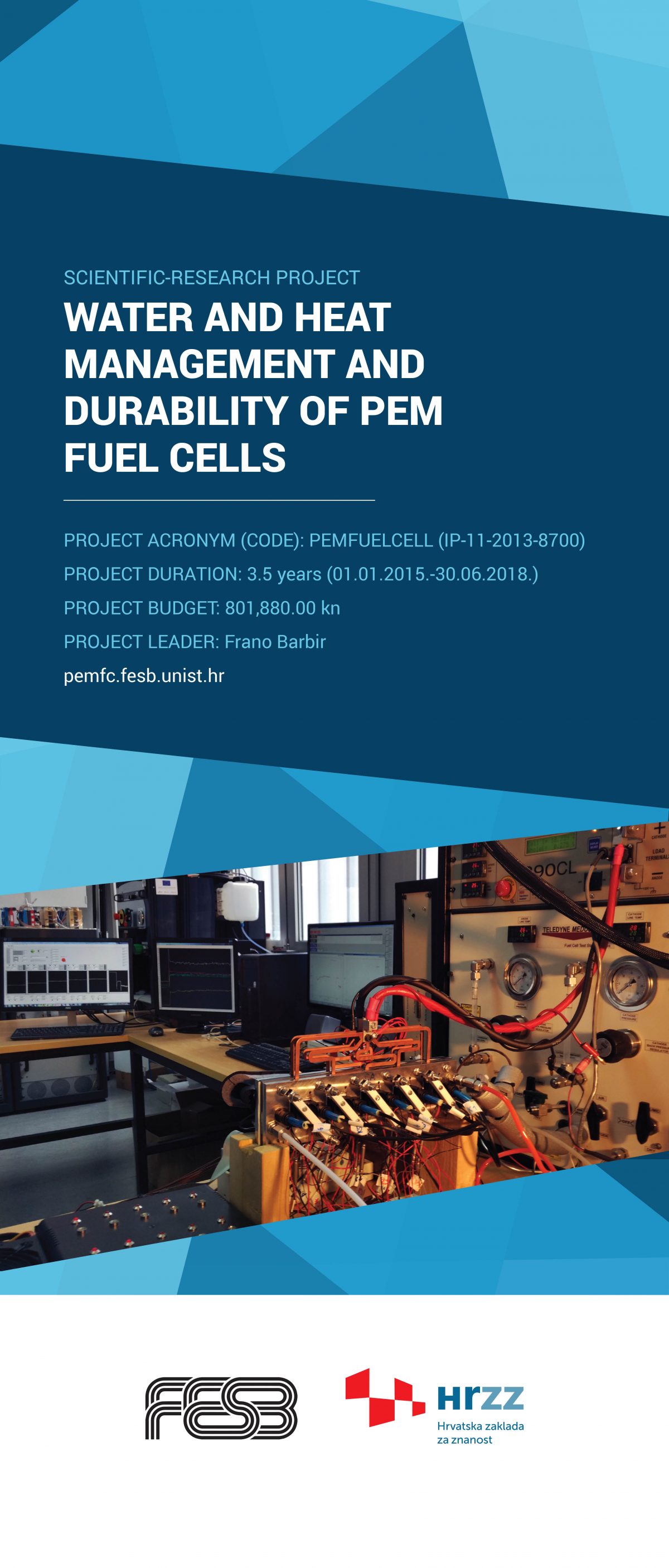Project name: Water and Heat Management and Durability of PEM Fuel Cells
Acronym (code): PEMFUELCELL (8700)
Funding: Croatian Science Foundation (HRZZ)
Project budget: 801,880.00 kn
Project leader: Prof. Frano Barbir, Ph.D.
Project start date: 01.01.2015.
Project finish date: 30.06.2018.
Contact: fbarbir@fesb.hr, ipivac@fesb.hr
State-of-the-art
The subject of the proposed research and development are the fuel cells – devices for direct electrochemical conversion of fuel (usually hydrogen) into electricity, with many potential applications, from propulsion of vehicles to mobile and stationary power generation at different scales (from mW to MW).
Water plays an important role in low temperature polymer electrolyte membrane (PEM) fuel cells, as water is needed in the membrane for proton conduction. Although the fuel cell produces water, and in most cases this amount of water should be sufficient to keep the reactant gases fully humidified, most fuel cells need external humidification of the reactant gases. Introduction of ambient air in a fuel cell operating at elevated temperature (60-80 °C) without additional humidification would result in temperature of the air rising quickly after entering the stack causing severe drop in relative humidity. The product water in that entrance portion of the fuel cell would not be sufficient to prevent severe membrane dehydration. Eventually, down the cathode channel, the product water could be sufficient to humidify air, but significant portion of the cathode channel would be dry. Operation with dry gases would result in drying out of the polymer membrane, which would adversely affect the fuel cell performance and lifetime [1]. For that reason most fuel cells require external humidification of air.
Operation with dry gases, if possible, would eliminate the need for the devices required for external humidification, and therefore would result in simplification of the fuel cell system. Operation of fuel cell with dry gases has first been proposed by Buchi and Srinivasan (1997) [2]. Ever since, researchers have been studying this problem and attempting to solve it by varying internal configuration of flow channels inside the fuel cell [3-6], or by creating self-humidifying membranes by incorporating Pt or metal-oxide particles into their structures [7-13]. Here, a new concept is being proposed of not allowing dry conditions inside the fuel cell by controlling the local temperature, i.e., by imposing a temperature profile which would allow maintaining desired relative humidity (close to 100%) utilizing water produced in the electrochemical reaction inside the fuel cell.
[1] X. Huang, R. Solasi, Y. Zou, M. Feshler, K. Reifsnider, D. Condit, S. Burlatsky, T. Maddden, Journal of Polymer Science 44, 16 (2006) 2346-2357.
[2] F.N. Buchi and S. Srinivasan, Journal of Electrochemical Society 144 (1997) 2787-2772.
[3] R.K. Wynne, J.K. Neutzler, F. Barbir, V. Gurau, W.E. Pierce, III, (2001) U.S. Patent #6207312
[4] Z. Qi and A Kaufmann, Journal of Power Sources 109 (2002) 469–476.
[5] W.H.J. Hogarth and J.B. Benzinger, Journal of Power Sources 159 (2006) 968–978.
[6] S. Litster and J.G. Santiago, Journal of Power Sources 188 (2009) 82–88.
[7] M. Watanabe, H. Uchida, M. Emori, The Journal of Physical Chemistry B 102, (1998) 3129–3137.
[8] Naoki Inoue, Makoto Uchida, Masahiro Watanabe, Hiroyuki Uchida, Electrochemistry Communications 16 (2012) 100-102.
[9] Y. Zhang, H. Zhang, X. Zhu, L. Gang, C. Bi, Y. Liang, Journal of Power Sources 165 (2007) 786–792.
[10] C. Bi, H. Zhang, Y. Zhang, X. Zhu, Y. Ma, H. Dai, S. Xiao, Journal of Power Sources 184 (2008) 197–203.
[11] U.H. Jung, K.T. Park, E.H. Park, S.H. Kim, Journal of Power Sources 159 (2006) 529–532.
[12] U.H. Jung, S.U. Jeong, K.T. Park, H.M. Lee, K. Chun, D.W. Choi, S.H. Kim, International Journal of Hydrogen Energy 32 (2007) 4459–4465.
[13] H.-N. Su, L. Xu, H. Zhu, Y. Wu, L. Yang, S. Liao, H. Song, Z. Liang, V. Birss, International Journal of Hydrogen Energy 35 (2010) 7874–7880.

